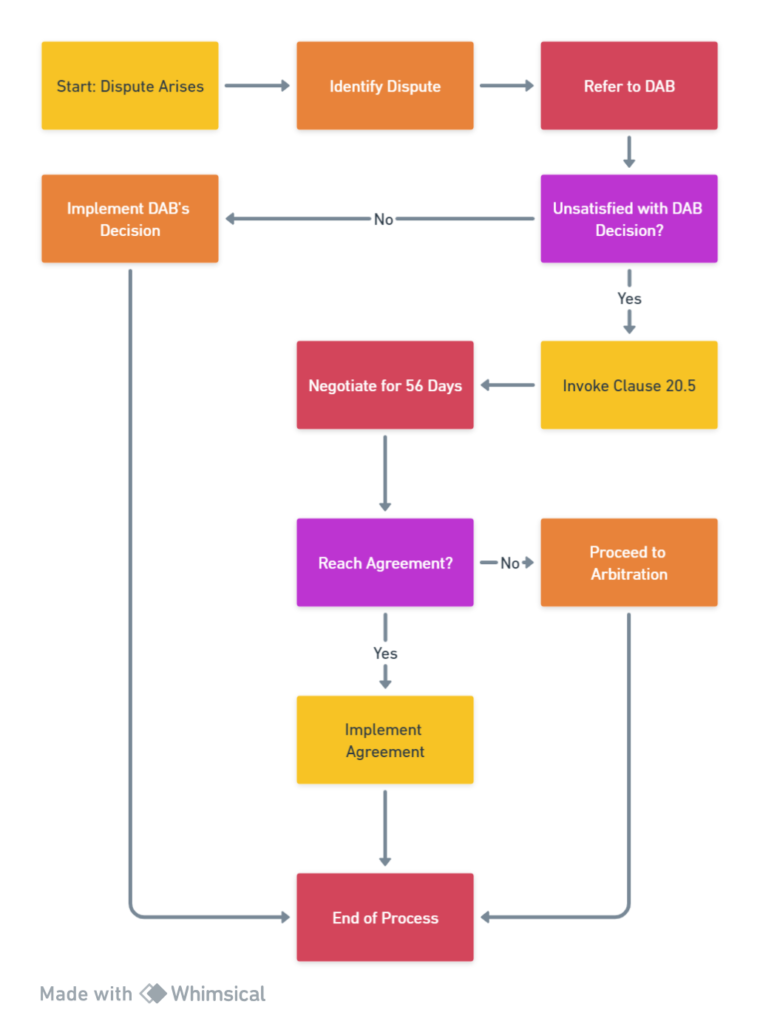Clause 20.5 (1999) vs Clause 21.3 (2017)
Amicable Settlement “cool-down” vs. DAAB-led dispute avoidance
Purpose of the Clause
Let’s start by understanding why these clauses even exist.
🧾 Clause 20.5 (1999) – The “Cool-Down” Clause
This clause was designed as a mandatory cooling-off period. Once a party says, “I don’t accept the DAB’s decision” (by issuing a Notice of Dissatisfaction), FIDIC tells both parties, “Alright, pause. Take 56 days to try and talk it out before jumping into arbitration.”
It’s a good-faith nudge toward negotiation. But here’s the catch—it’s not enforced. Even if the parties just sit there and do nothing for 56 days, they’re free to proceed to arbitration. So while it sounds cooperative, it’s more of a procedural speed bump than a genuine attempt at resolution.
📜 1999 Clause 20.5 – Full Text (tap to expand)
“Where notice of dissatisfaction has been given under Sub-Clause 20.4 above, both Parties shall attempt to settle the dispute amicably before the commencement of arbitration. However, unless both Parties agree otherwise, arbitration may be commenced on or after the fifty-sixth day after the day on which notice of dissatisfaction was given, even if no attempt at amicable settlement has been made.”Source: FIDIC 1999, Sub-Clause 20.5 (Amicable Settlement)
Where notice of dissatisfaction has been given under Sub-Clause 20.4 above, both Parties shall attempt to settle the dispute amicably before the commencement of arbitration. However, unless both Parties agree otherwise, arbitration may be commenced on or after the fifty-sixth day after the day on which notice of dissatisfaction was given, even if no attempt at amicable settlement has been made.
🤝 Clause 21.3 (2017) – The “Let’s Fix This Early” Clause
FIDIC took a big leap in 2017. Instead of waiting until a full-blown dispute erupts, Clause 21.3 brings the DAAB in before things go off the rails—more like relationship counseling than courtroom drama.
In short:
1999: “Talk it out, if you feel like it.”
2017: “Let’s not even get to the fighting stage.”
📘 2017 Clause 21.3 – Key Provisions (tap to expand)
- The DAAB can be involved at any time, not just after disputes arise.
- It’s voluntary—both parties make a joint request.
- DAAB can offer advice, facilitate dialogue, and help clarify misunderstandings.
- Informal DAAB advice is non-binding.
🚨 What this means in practice (1999)
- •No incentive to genuinely attempt resolution during the 56-day pause.
- •DAB’s role ends after issuing its decision.
- •Disputes often jump straight to arbitration.
- •Reactive posture—problems tackled only after they escalate.
✅ What this enables (2017)
- ✓Encourages dialogue before issues harden into disputes.
- ✓Keeps the DAAB engaged throughout the project lifecycle.
- ✓Reduces cost and time spent on arbitration.
- ✓Builds trust via early, facilitated resolution.
⏱️ The 56-Day “Cool-Down” (1999)
Trigger: Notice of Dissatisfaction (NoD) is issued under 20.4 → 56 days → arbitration can commence, even if no amicable talks occurred.
🛠️ DAAB Early Involvement Flow (2017)
Sub-Clause 21.3 allows DAAB to assist anytime, on a joint request or by inviting one.
Key terms at a glance
Quick check: which clause pushes for early avoidance?
Disclaimer: Educational summary. Always read the Contract Particulars and applicable FIDIC book in full before acting.
Clause 20.5 (1999): Amicable Settlement – Flow & Guide
A practical walkthrough of the 56-day negotiation period after a Notice of Dissatisfaction (NoD).
Dispute Resolution Flow (1999 • Clause 20.5)
Tip: The “Unsatisfied with DAB?” decision is what triggers the amicable settlement window.
⏱️ 56-Day Amicable Settlement Timeline (post-NoD)
Reminder: Clause 20.5 creates a 56-day amicable settlement window after an NoD is issued under 20.4. Arbitration may commence thereafter even if no talks occurred. Always read your Contract Particulars.
Clause 20.5 (1999): Amicable Settlement — Interactive Checklists
Plan, execute, and monitor the 56-day negotiation window after a Notice of Dissatisfaction (NoD) with practical, trackable steps.
Planner Inputs (to compute due dates)
Tip: Enter the DAB Decision Date. Add other dates as they happen; the tool recalculates “latest by” deadlines automatically.
Disclaimer: Educational checklist. Always check your Contract Particulars and the relevant FIDIC book before acting.

